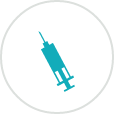Birth Control Tool
When it comes to pregnancy prevention, there are several birth control options to consider. Choosing a method that best fits with a person’s life will give them the best protection because they’ll be more likely to use it correctly and consistently. It’s important for them to talk to their health care provider about the method of birth control that’s right for them.

A hormone pill taken every day to prevent pregnancy.
Pregnancy Protection?
91%*
STI Protection?
No
*with typical use

A hormone (progestin) injection given to prevent pregnancy.
Pregnancy Protection?
94%*
STI Protection?
No
*with typical use

A thin covering that fits over a hard (erect) penis to prevent pregnancy and STIs.
Pregnancy Protection?
82%*
STI Protection?
Yes
*with typical use

A pill or IUD that is used if a person has had unprotected sex or are not sure if they are protected from pregnancy.
Pregnancy Protection?
IUD: 99%*
Pill: 50% - 90%*
STI Protection?
No
*with typical use

A small, soft, T-shaped device that is put in the uterus by a health care provider to help prevent pregnancy. Can be copper or hormonal type.
Pregnancy Protection?
99%*
STI Protection?
No
*with typical use

A small sticky patch worn on the skin that releases hormones to prevent pregnancy.
Pregnancy Protection?
91%*
STI Protection?
No
*with typical use

A flexible latex or silicon disc that is put in the vagina and used with a spermicidal gel.
Pregnancy Protection?
84%*
STI Protection?
No
*with typical use

A clear plastic ring that is put in the vagina to prevent pregnancy.
Pregnancy Protection?
91%*
STI Protection?
No
*with typical use
<!–
var iFrame = document.getElementById( ‘iFrame1’ );if(window.innerWidth = 493 && window.innerWidth = 678 && window.innerWidth = 1481){iFrame.height = 1400;}
window.onresize = function() {console.log(window.innerWidth);var iFrame = document.getElementById( ‘iFrame1’ );if(window.innerWidth = 493 && window.innerWidth = 678 && window.innerWidth = 1481){iFrame.height = 1400;}}–>








